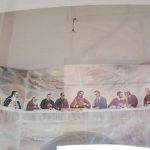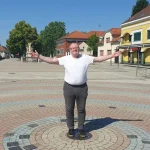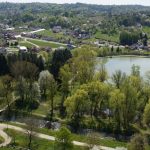November 10, 2019 – The Last Supper in Ludbreg, the only town in Croatia with a physical miracle certified by the Vatican has an unusual fresco with the disciples of Jesus replaced by Croatian saints and holy people. So who exactly are they?
Almost everyone I have spoken to about this in Croatia in recent weeks has either had no idea whatsoever, or very limited knowledge, apart from about 2-3 people. With more than one million tourists a year in Medjugorje in neighbouring Bosnia and Herzegovina, very few religious pilgrims going there have ever heard of Ludbreg, a small town in Varazdin County just north of Zagreb. And yet, with the Vatican has yet to recognise anything in Medjugorje, Ludbreg is home to the only physical miracle in all Croatia which has been certified by the Vatican. You can read the original story in full here, but to recap:

The Real Presence website gives a great overview of the history of Ludbreg’s miracle.
In 1411 at Ludbreg, in the chapel of the Count Batthyany’s castle, a priest was celebrating Mass, during the consecration of the wine, the priest doubted the truth of transubstantiation, and the wine in the chalice turned into Blood. Not knowing what to do, the priest embedded this relic in the wall behind the main altar. The workman who did the job was sworn to silence. The priest also kept it secret and revealed it only at the time of his death. After the priest’s revelation, news quickly spread and people started coming on pilgrimage to Ludbreg. The Holy See later had the relic of the miracle brought to Rome, where it remained for several years. The people of Ludbreg and the surrounding area, however, continued to make pilgrimages to the castle chapel.
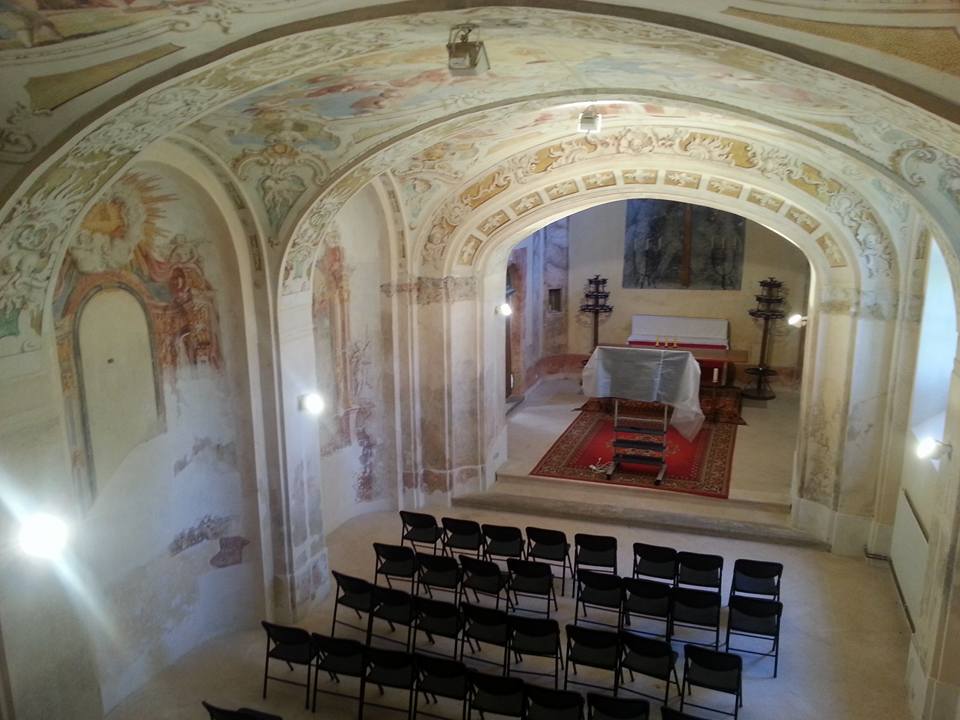
In the early 1500s, during the pontificate of Pope Julius II, a commission was convened in Ludbreg to investigate the facts connected with the Eucharistic miracle. Many people testified that they had received marvelous cures while praying in the relic’s presence. On April 14, 1513, Pope Leo X published a Bull permitting veneration off the holy relic which he himself had carried in procession several times through the streets of Rome. The relic was later returned to Croatia.
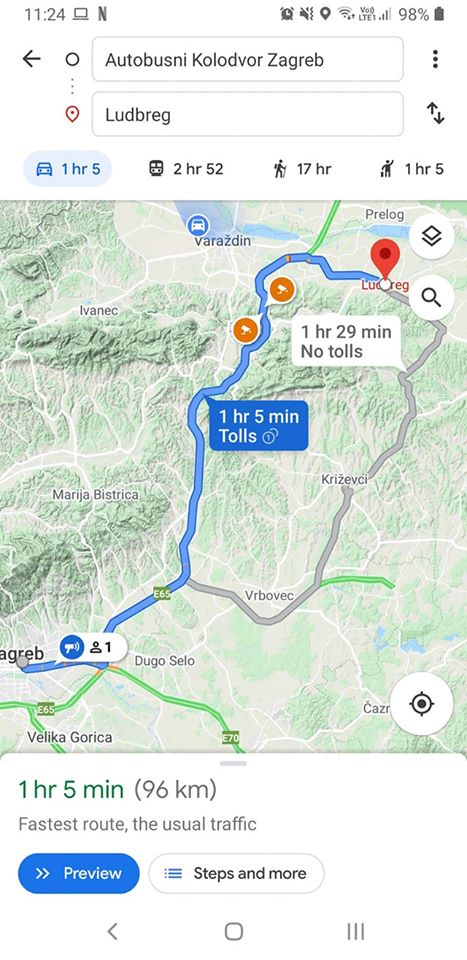
In the 18th century northern Croatia was ravaged by the plague. The people turned to God to call upon His help, and the Croatian Parliament did the same. During the session held on December 15, 1739 in the city of Varazdin, they vowed to build a chapel at Ludbreg in honor of the miracle if the plague ended. The plague was averted, but the promise vow was only fulfilled in 1994, when democracy was restored in Croatia. In 2005 in the votive chapel, the artist Marijan Jakubin painted a large fresco of the Last Supper in which Croatian saints and blesseds were drawn in place of the Apostles. St. John was replaced with Blessed Ivan Merz, who was included among the 18 most important Eucharistic saints in the Church’s history during the Synod of Bishops held in Rome in 2005. In the painting, Christ is holding in His hand a monstrance containing the relic of the Eucharistic miracle.
And that large fresco of Croatian saints and blesseds was incredible and very unique. I have never seen anything like it before. It was painted by Marijan Jakubin, an academic painter.
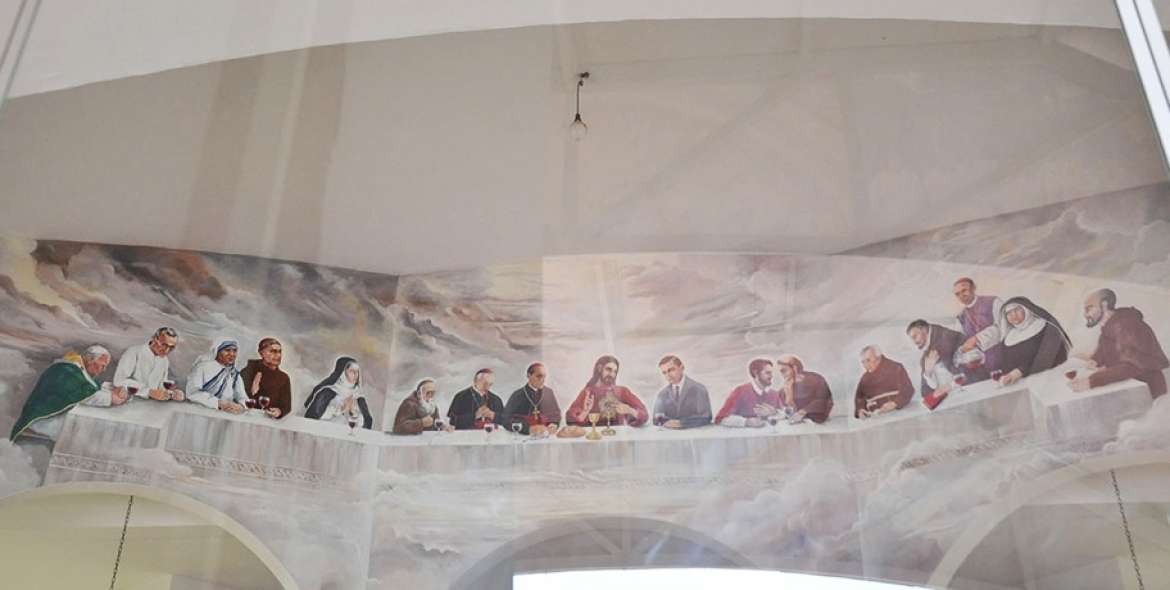
I have been to many churches in Croatia, but never seen anything like it.
So who are the people with Jesus at this very Croatian Last Supper in Ludbreg? From left to right, there is a brief description of each, apart from the very famous ones, Pope John Paul II, Mother Teresa, and Cardinal Stepinac.
Pope John Paul II
Father Ante Gabric – Born in Metkovic in 1915, Gabric joined the Jesuits at an early age. On October 20, 1938, after obtaining special permission from his Jesuit superiors, Gabric left for India, his ‘promised land,’ by steamship, where he became a very close aid to Mother Teresa. Exactly fifty years later to the day, October 20, 1988, he passed away.
Mother Teresa
Brother Vendelin Vosnjak – Born in Slovenia in 1861, Vendelin Vosnjak joined the Franciscan Order in 1878 and was ordained a priest i n1884. The founder of the Croatian Franciscan Province of Sv. Cyril and Methodius in 1900, he encouraged the restoration of spiritual life, churches and monasteries, as well as the publication of religious magazines. He was proclaimed a servant of God in 2000, and the process of his canonisation is ongoing. He died in 1933.
Osanna of Cattaro was a Catholic visionary from Kotor born in 1493 and who died in 1565. She was a teenage convert from Orthodoxy and became a Dominican tertiary and was posthumously venerated as a saint in Kotor. She was later beatified in 1934.
Saint Leopold B. Mandic (also known as Leopold of Castelnuovo) was born in 1866 and died on 30 July 1942. He was a Croatian Capuchin friar and Catholic priest, who suffered from disabilities that would plague his speech and stature. He developed tremendous spiritual strength in spite of his disabilities and became extremely popular in his ministry as a confessor, often spending 12–15 hours in the confessional. Although Mandic wanted to be a missionary in Eastern Europe, he spent almost all his adult life in Italy, living in Padua from 1906 until his death. He also spent one year in an Italian prison during World War I, since he would not renounce his Croatian nationality.[2] He also dreamed unceasingly about reuniting the Catholic and Orthodox churches and going to the Orient. He became known as an Apostle of Confession and an Apostle of Unity. He made a famous prayer that is the forerunner of today’s ecumenism.As a result of the bombing during World War II, the church and part of the friary where Mandic lived were demolished, but his cell and confessional were left unharmed. He had predicted this before his death, saying, “The church and the friary will be hit by the bombs, but not this little cell. Here God exercised so much mercy for people, it must remain as a monument to God’s goodness.” Pope Paul VI beatified Leopold on 2 May 1976. He was canonized by John Paul II during the General Assembly of the Synod of Bishops on 16 October 1983. Leopold is hailed as the “Apostle of Unity”.
Cardinal Franjo Kuharic (15 April 1919 – 11 March 2002) was a Croatian Catholic cardinal, who served as the Archbishop of Zagreb from 1970 until his resignation in 1997. The cardinal was often referred to as the “Rock of Croatia” known for his defence of human rights and his urging of peace and forgiveness during the independence conflict and the Bosnian War. Kuharic was also a vocal supporter of the cause for the canonization of Cardinal Alojz Stepinac (who had ordained him as a priest in 1945) and worked to rehabilitate the image of the cardinal during his episcopate while working towards Stepinac’s 1998 beatification held in Zagreb. His cause for canonization commenced on 11 March 2012 and he has been titled as a Servant of God.
Cardinal Alojz Stepinac
Blessed Ivan Merz (16 December 1896 – 10 May 1928) was a Croatian lay academic, beatified by Pope John Paul II on a visit at Banja Luka, Bosnia and Herzegovina on June 22, 2003. Ivan Merz promoted the liturgical movement in Croatia and together with Ivo Protulipac created a movement for the young people, “The Croatian union of the Eagles” (“Hrvatski orlovski savez)”, inspired by the “Eucharistic Crusade,” which he had encountered in France. The Director of the Confraternity, Dave Ceasar Dela Cruz was elected as the Vice Postulator of the Cause for the Canonization of Blessed Ivan Merz on 19 March 2008 by the Vatican through the Congregation for the Causes of Saints.
Saint Marko Krizevcanin was a Croatian Roman Catholic priest, professor of theology and missionary, who was active in the 17th century. In the course of the struggle between Catholicism and Calvinism in the region then, he was executed for his faith. He has been declared a saint by the Catholic Church, the third Croat to be so honored.
Nikola Tavelic was a Franciscan missionary who died a martyr’s death in Jerusalem on November 14, 1391, a Croatian friar. He was beatified as part of Nicholas Tavelic, O.F.M. and companions, which included friars from Italy and France. All four members of his group have been declared saints by the Catholic Church, making Tavelic the first Croatian saint.
Ante Antic (Sepurine, Prvic Island, April 16, 1893 – Zagreb, March 4, 1965), Croatian Catholic priest, Franciscan, confessor, spiritual leader, servant of God, candidate for sainthood. There has been a process since 1984 to declare him a saint. The cause was opened by Cardinal Franjo Kuharic; the case has been taking place in Rome since 1995. More than 5,000 hearings have been recorded. He is one of the most beloved priests of the past century in Croatia. On May 5, 2015, he received the title of Holy Servant of God.
Augustin Kazotic (1260 – 3 August 1323) was a Dalmatian-Croatian Roman Catholic prelate and professed member from the Order of Preachers who served as the Bishop of Lucera from 1322 until his death. Kazotic was a humanist and orator who had served first as the Bishop of Zagreb from 1303 until 1322. Kazotic studied in Paris before returning to his homeland where he began working in the missions and preaching in modern Bosnia. He was one of the first humanist figures to appear in southern Croatia. His reputation for personal holiness remained noted long after his death; this resulted in Pope Innocent XII confirming the late bishop’s beatification in 1700.
Marija Petkovic is also known as “The Blessed Mary of Jesus Crucifi ed Petkovic”; (Croatian: Marija od Propetoga Isusa Petkovic, Italian Maria Di Gesù Crocifisso), (10 December 1892 – 9 July 1966) was the founder of the Catholic Congregation of the Daughters of Mercy. She was recognized by the Roman Catholic Church as a Venerable Servant of God on 8 May 1998, and was beatified by Pope John Paul II on 6 June 2003.
Gracija Kotorski (Muo, Boka Kotorska, 27th of November 1438 – Venice, 9th of November 1508), a beatified Catholic, Augustinian monk, fisherman and seaman. Born as Pavao Krilovic. Until his thirties, he lived in Boka Kotorska as a fisherman. Then he went out into the world sailing just like a sailor. On his visit to Venice in 1454, he was delighted with the sermon of Blessed Šimun Kamerin, and he encouraged him to give up his worldly life and devote himself to a religious path. He went to the Augustinian monastery on Ortone Hill near Padua, where he remained for 15 years.
To follow the latest from Croatia’s miracle town of Ludbreg, click here.
(With thanks to Miranda Milicic Bradbury for additional research)


